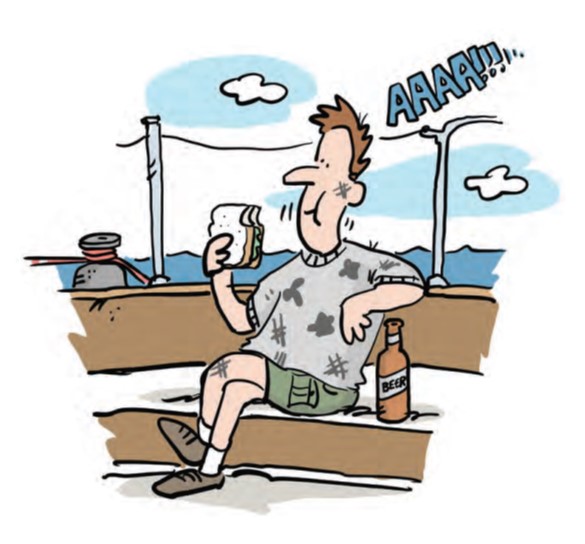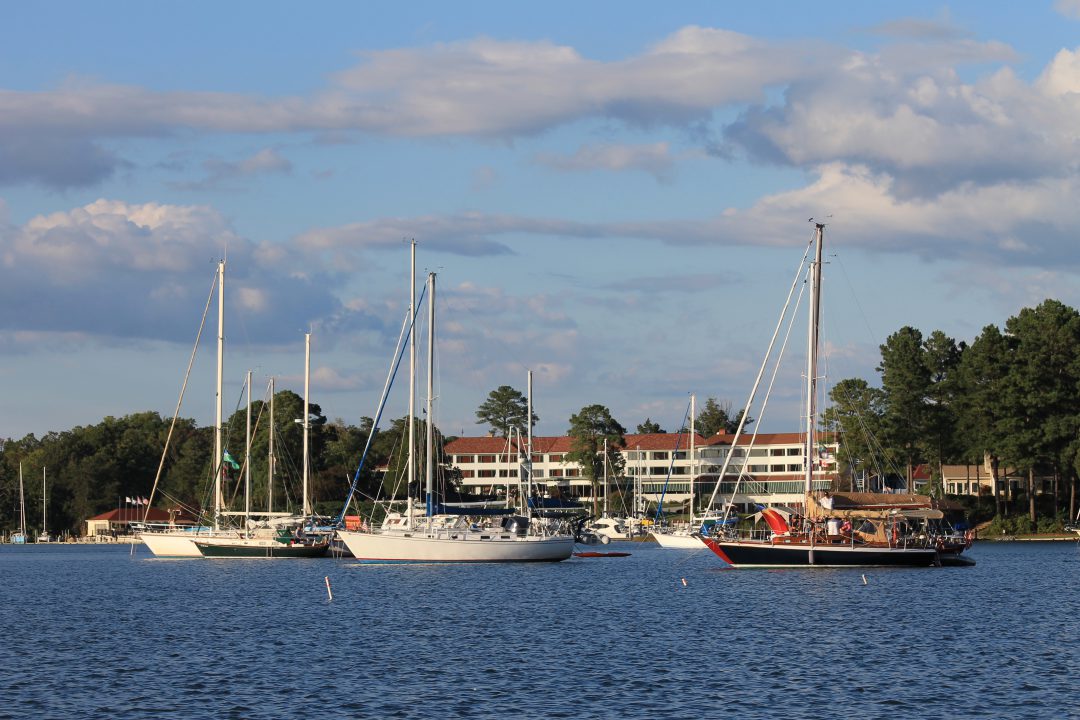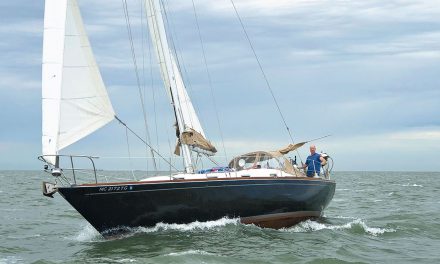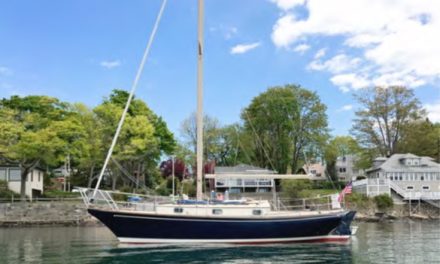A pleasant amble up the ICW is rudely interrupted by a near-sinking.
Issue 142: Jan/Feb 2022
It’s a hot August day, Mile Marker Somewhere, along a meandering stretch of well-marked rivers down in South Carolina’s portion of the Intracoastal Waterway (ICW). Too hot for alligators, I guess, but there’s enough of a breeze to fill the jib, so I throttle back the diesel.
My version of motorsailing Traveller, my 1968 Cheoy Lee Luders 36, is to unfurl the big jib and keep the diesel clicking along just enough to glide on through the dead spots. The mainsail is tucked away on the boom above the canvas bimini.
I am not built for these warm, southern waters, but the boat doesn’t seem to mind the heat.
I’ve only had Traveller for about a month and am working my way up the ICW, chancing along, as they say in Maine, as I try to make my way north and home. A cold beer and a sandwich—that’s what a fella wants on a hot day like this. Maybe at the next mile marker I’ll drop the little Fortress anchor and make lunch.
And that’s when it happens.
First comes the sound—the electric, brain-stabbing shrill of the high-water alarm. It shocks the heck out of me. I slide back the companionway hatch; my blurry reflection sloshes back and forth up at me from the cabin sole.
That noise! It doesn’t help that the cabin resounds like an echo chamber. And where is all this water coming from anyway?
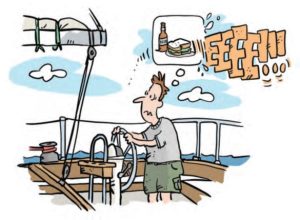
Illustrations by Tom Payne
The previous owner, a cunning old devil and crooked as a fish hook, had proudly showed me his “bombproof” pump system: two Rule-o- Matic float switches, one above the other, with a high-water alarm wired into the top one. Of course, he never left the dock, and like a dope, I never checked his electrical connections.
Now, I’m furious at him and at myself, but this is no time to fume. It’s time to act.
I furl the jib smoothly and dart forward to lower the anchor, stopping briefly enough at the bow pulpit to hurl a few choice words and have a good yell. I return aft, push the throttle into reverse to set the hook, and pop the throttle into neutral. A quick look up and down the river, then I splash down into the cabin.
The water is warm and not quite up to my ankles. Reaching beneath it, I pull up a floorboard.
Both Rule switches have failed, but luckily, not the alarm. The pump is in the deepest part of the bilge and cable-tied to a long, wooden dowel. I pull up the oily pump and find that the taped wires have pulled loose. The float switch dangles limply from the pump; its corroded wire ends are loose and waterlogged.
The previous owner had cobbled together short pieces of wire and loosely wrapped them with black electrical tape. He didn’t use butt connectors, heat-shrink tubing, or marine sealant; he just stripped them back, twisted and then taped them together. Now the tape is waterlogged, oily, and falling off. The exposed copper ends are wet and green with corrosion.
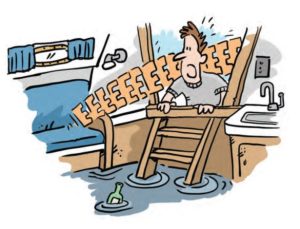
Suddenly, like a diver underwater, I feel like I’ve been down here too long.
Back up the companionway steps and into the cockpit. The Perkins diesel is still clicking over, but I have noticed that the ICW is starting to lap at the motor mounts. I shut down the engine. The sound of the alarm is louder now as it cuts through the hot air.
I find my last penciled position on the paper chart and glance at the depth finder. I’m thinking that maybe I can make my way over to the edge of the river and ground myself in a shallow area while I work on the bilge pump.
I look at the soundings: 8 to 12 feet with nothing shallow nearby. The banks are sheer. Traveller draws 5 feet 6 inches. Half the time the problem in the ICW is shoals when you don’t want them, and now that I want one, there isn’t one!
I cannot believe that my old boat is going to sink along this quiet stretch of water.
But, no! Hell no!
Until now, my new life with my old boat had been pretty uneventful. Sure, there had been some large (expensive) and small (annoying) problems, but nothing as black and white, nothing as dire, as this. Options furiously tick through my brain, and it suddenly occurs to me that it’s just me and the boat now. I might as well be in mid-ocean. No one else is around to help me. Besides, what could they do?
Pump! They could help me pump.
I break out the manual pump, a big Whale Gusher. It’s screwed down to a wooden board. The handle is short but luckily tethered to the pump. I rake through a heap of rusty tools, old gloves, an old roll of duct tape, a spool of red wire, and a 10-foot length of black plastic exhaust hose that I’d bought on one of my many trips to West Marine. I pat myself on the back for being so clever and forward thinking. Oh yes, I’m a mariner. I set up the Gusher in the cockpit, shove in the hose, and start pumping like a man possessed.
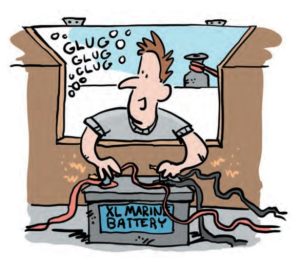
The old rubber diaphragm disintegrates on the first pull. Just rips to crumbly bits.
I decide that now would probably be a good time for a primal scream. It cannot compete with the high-water alarm though. Subconsciously, I think, Well, the water hasn’t reached the batteries yet.
The batteries. I remember that I have another spare Rule float switch in a cabinet down below, so I slide down the companionway steps to grab it. I can wire it from the batteries to the bilge pump and get it going again.
Back in the cockpit, I fumble through the lazarette and pull out that spool of red wire, 12-gauge. Might as well grab the duct tape, too.
From the spool, I cut off two long lengths with my Swiss Army knife, then peel back a couple inches of insulation at each end. I twist the gleaming copper ends to the float switch wires and duct tape over the whole thing.
Wait—forget the float switch! The bilge pump’s wires can lead straight to the battery. I pull off the float switch. That can get rigged up later.
I pull the bilge pump out of the water and twist and tape the new red wires to the pump’s gnarly old ones. Then I push the exhaust hose back onto the pump housing and lower it down into its home in the bilge. I take the free ends of the wires and dash back up to the cockpit, where the batteries are located in the starboard lazarette. I touch the wires to the battery terminals.
Sparks! Then, from deep down in the bilge, there’s a whirring sound. And after a minute or so, I hear a wonderful new sound. Water is gushing out of the boat from the transom through hull. It takes several minutes, but the high-water alarm finally shuts the heck up.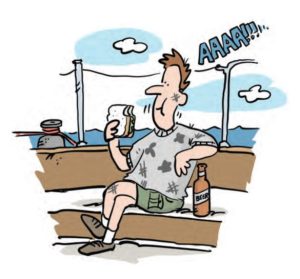
A seagull squawks in the distance. The main halyard clanks against the mast. I keep kneeling in the cockpit, holding those wires to the battery terminals and listening.
The water continues pouring out, then turns into a trickle, then there’s only an airy sputtering. I pull the wires off the battery.
Around me, my new old boat is torn apart. The lazarette hatches are both open and their contents are strewn all over the cockpit. Down below, the cabin sole is still opened up, the floorboards soaked. The contents of a cabinet are spread across the settee. My finger is bleeding; my bare feet are oily.
But man, am I happy. No. I’m more than happy. I am serene. I am not sinking. I let this brief moment of victory sink in (no pun intended).
Then I check through hulls and hoses looking for a possible source of the leak. I suspect the stuffing box, but it’s not until later, in a marina, that I find the true source of the problem. For now, the water seems to be staying where it’s supposed to—outside the hull—so I rig the new float switch (properly), fire up the diesel, and continue on my merry way…with a wary eye on the bilge.
And, that sandwich— remember the sandwich? That was probably one of the best sandwiches I’ve ever had. And damn! That ice-cold beer hit the spot.
David Bond is a writer and artist from Maine. He currently teaches English in Germany while Traveller rests ashore in the Chesapeake. They will continue their adventures together soon. Before wading into teaching, David operated a sailboat chartering business in Kennebunkport, Maine. His book, Adventures in the Charter Trade, is about those crazy times and is available on Amazon.com.
Thank you to Sailrite Enterprises, Inc., for providing free access to back issues of Good Old Boat through intellectual property rights. Sailrite.com

